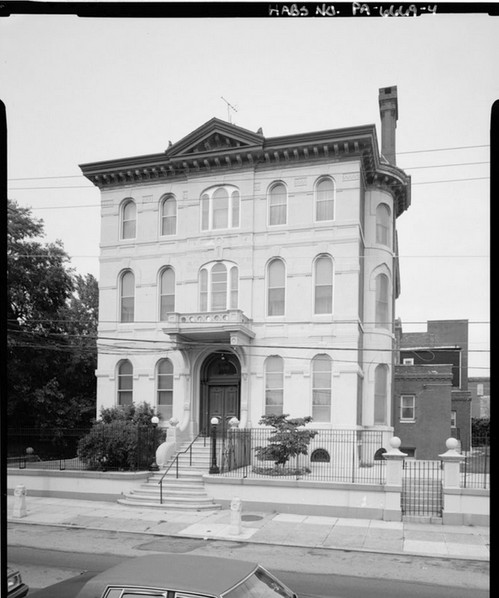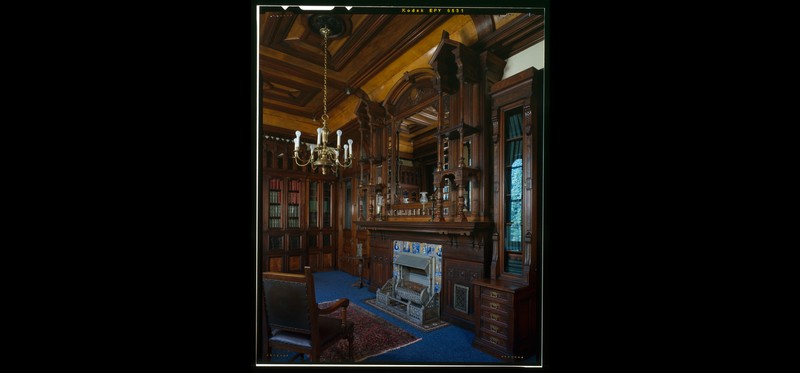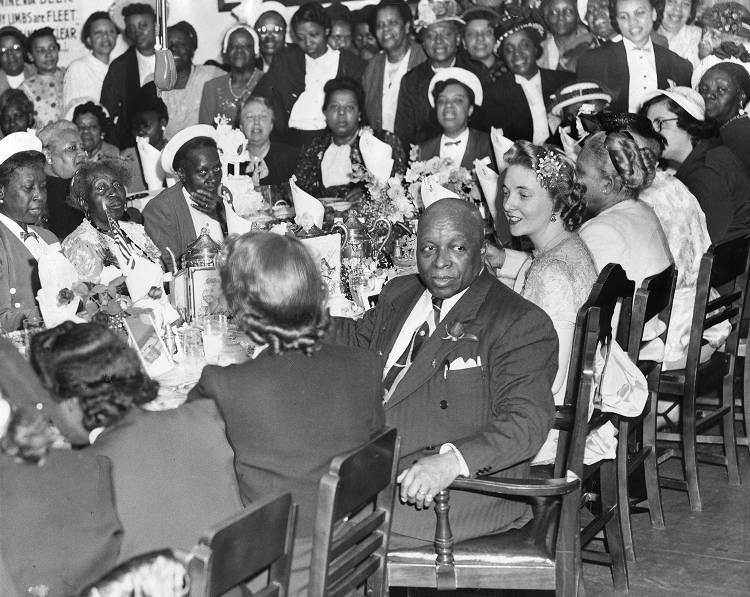Disston Mansion
Introduction
Text-to-speech Audio
The Disston House was designed by renowned architect Edwin Forrest Durang for Albert H. Disston, son of the wealthy industrialist Henry Disston. Construction began on the house in 1881 and was completed in 1882 with renovations taking place in 1906 and 1920. Today, the mansion is the home to the Unity Mission Church Home Training School Bible Institute.
Images
Disston House, 1530 North Sixteenth Street, Philadelphia, Philadelphia County, PA

Disston House, 1530 North Sixteenth Street, Philadelphia, Philadelphia County, PA

Father Divine and Mother Divine at a luncheon for their anniversary, Disston Mansion, 4/30/1951

Backstory and Context
Text-to-speech Audio
The late-Victorian Mansion located at 1530 N. 16th Street is one of the last remaining mansions built for Philadelphia’s industrial elite during the early years of the late 19th-century "second Industrial Revolution". The original tenant, Albert H. Disston, was the son of wealthy industrialist Henry Disston. Disston, an English immigrant, came to the United States in 1833 and began making saws. By 1850, he had established Keystone Saw Works, the largest sawmaking company in the world. After his son Hamilton returned from the Civil War, Henry renamed the company Disston Saw Works.
Following his father's death in 1878, Albert, along with his four brothers, received a large inheritance. Albert purchased three lots of land in 1881 and tapped Edwin Forrest Durang as the architect. Durang was known mostly for his notable Catholic churches, including the nearby Church of the Gesú at N 18th Street. Durang and his team began construction in June 1881 and the residence was finished by September 1882, although work on the interior furnishings would continue through the fall of 1882.
With the house completed, Albert, his wife Kate, and their four young children moved into the Mansion. Albert only lived in the Mansion for a little over a year, as he passed away at age 33 on October 21, 1883. Kate eventually remarried in 1896, and remained in the house with her two sons Albert and Frank. Her new husband, George K. Breintnall also moved into the house alongside his adult daughter. Along with their four servants, these five tenants lived in Disston Mansion until Kate's death in 1920, ending her life estate with the mansion.
The interior of the home was decorated by renowned interior designer George Herzog. Herzog, a German immigrant perhaps best known for his work with the Philadelphia Masonic Temple and the Union League of Philadelphia worked closely alongside Durang, blending his German training with American decor trends of the time. Herzog enjoyed extensive control over the decoration within the home, making decisions on nearly every feature in the home.
The house was incredibly luxurious and fit the upper-class neighborhood of North Philadelphia. During the late 1800s, wealthy Philadelphians preferred to live in North Philadelphia on account of the space available and their mostly wealthy Protestant neighbors. Around the time of Albert’s death in 1883, the demographics of the neighborhood began to change. With the original owners of the homes in the neighborhood dying out their descendants selling the homes, Jewish families and local institutions began to move into the vast spaces on and around Sixteenth Street. The Progress Club purchased Disston in 1920 and stayed for 11 years until 1931. During their occupancy, the club made many additions to the home, including a kitchen addition and a two story Palm Room. After Max Blumenthal bought Disston from the Progress Club in 1931, he sold the property to the Bible Institute of Pennsylvania in 1935. The Unity Mission Church Home and Training School purchased the home in 1946.
The Unity Mission Church Home and Training School was created by the charismatic, philanthropic, and messianic leader, Father Divine. Through social and economic programs for his followers, Father Divine began to grow the size and influence of his Church. Although it began in New York, Father Divine relocated his movement to Philadelphia in 1942, in part to avoid legal difficulties. They bought many properties in Philadelphia for housing as well as creating churches. The most famous of their properties is the Divine Lorraine Hotel. Purchased by Divine in 1948, the Lorraine became the first fully racially integrated hotel in the United States. The hotel operated for nearly 50 years until closing in 1999.
The purchase of the Disston Mansion in 1946 came two years before the Divine Lorraine, but the church already owned property in the area, having purchased and maintained another mansion at 1430 N. Broad Street, just a few blocks away. Disston Mansion has been owned and operated by members of the Unity Mission Church Home and Training School ever since, although no one has lived there permanently since 2000.
Cite This Entry
Joel Goldstein on behalf of Girard College and Katherine Haas. "Disston Mansion." Clio: Your Guide to History. December 20, 2022. Accessed March 30, 2025. https://theclio.com/tour/2392/13/reverse
Sources
Rilling, D. J. (2000). Green Hill Presbyterian Church HABS Pa-6668 (Girard Avenue Presbyterian ... loc.org. Retrieved October 15, 2022, from https://tile.loc.gov/storage-services/master/pnp/habshaer/pa/pa3800/pa3861/data/pa3861data.pdf
Historic American Buildings Survey, C., Disston, A. H., Disston, K. E., Durang, E. F., Herzog, G., Hale & Kilburn Manufacturing Company [...] Arzola, R. R., Elliott, J., photographer. (1933) Disston House,North Sixteenth Street, Philadelphia, Philadelphia County, PA. Pennsylvania Philadelphia County Philadelphia, 1933. Documentation Compiled After. [Photograph] Retrieved from the Library of Congress, https://www.loc.gov/item/pa3862/.
Unknown. (1951). Father Divine and Mother Divine at a luncheon for their anniversary. photograph, retrieved from George D. McDowell Philadelphia Evening Bulletin Photographs, Special Collections Research Center, Temple University Libraries, Philadelphia, PA.
Historic American Buildings Survey (Library of Congress)
Historic American Buildings Survey (Library of Congress)
George D. McDowell Philadelphia Evening Bulletin Photographs, Special Collections Research Center, Temple University Libraries, Philadelphia, PA.

